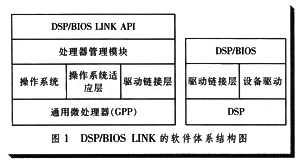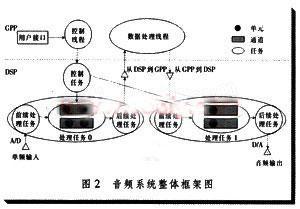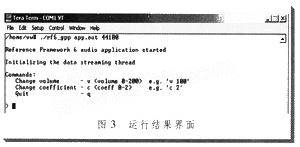The open multimedia application platform ((pen MuITImedia Appli-caTIons PIatform, OMAP) is a high-performance multimedia processor developed for third-generation mobile phones. In addition to the performance/power ratio advantages, it also provides a rich peripheral interface that supports almost all popular wired and wireless interface standards. Because of its outstanding performance, the platform has always been favored by the world's major mobile device manufacturers (such as Nokia, Ericsson, Sony, etc.).
The 0MAP5912 features a unique dual-core architecture with a processor with TI-enhanced ARM926EJ-S core for control and a high-performance, low-power TMS320C55x DSP core for data processing. The arm processor can be used to implement various communication protocols, controls, and human-machine interfaces; the DSP has multiple data address buses, which is ideal for data-intensive multimedia processing (such as video codec) and has extremely low power consumption [l]. In order to combine the advantages of these two processors to maximize their efficiency, the dual-core communication mechanism plays a crucial role.
1. OMAP5912 dual-core communication methodThere are two kinds of shared mailbox registers and shared storage space in the ARM and DSP dual-core communication modes in 0MAP5912. In practice, these dual-core communication methods need to be used together. For example, in the dual-core communication, the handshake is small, and the shared message can be used to transmit the message in a timely and reliable manner. When a large amount of data (such as image data) needs to be transmitted, it is usually necessary to use a highly efficient shared storage space. .
2.1 shared mailbox register modeThe dual cores can interrupt each other and pass a small amount of data through the mailbox register. There are 4 sets of mailbox registers, each set of mailbox registers consists of 2 16-bit registers and 1 1-bit register. When a processor writes the appropriate command word to the command word register, the register generates an interrupt and the flag register of the other processor is properly set. The interrupted processor responds to the interrupt by reading the flag register and clears the flag register. Each set of mailbox registers also has an additional data word register that transfers 2 words of data between processors at each interrupt. The information communicated through commands and data words is completely user defined. Data words can be used to represent address pointers or status words.
2.2 shared memory mode
There are two ways to share memory. In the first way, ARM obtains access to the DSP storage space and I/O space through the host interface (MPUI Interface, MPUI), and the data is moved between the dual cores by the arm. The MPUI provides a bridge between the MPU and the system DMA controller to communicate with the DSP and its peripherals. The MPuI provides access to the entire memory space of the DSP and its common peripheral bus.
Another way is that the ARM maps the external storage space of the DSP to the OMAP5912 system storage resource by setting the DSP Memory Management Unit (MMU), and the DSP completes the data transmission between the dual cores. The OMAP5912 implements shared memory through a Traffic Controller (TC), so that arm and DSP can access shared static random access memory (StaTIcRAM, SRAM), high-speed external memory interface (I, Zxteraaal: Mem0ry Interface Fast, EMIFF) and low-speed external memory. Ex-terhal Memory Interface Slow (EMIFS) storage space [2].
3 Basic application for communication between dual coresIn order to reduce the difficulty of implementation of upper-layer application developers and save design time, the basic application of dual-core communication--DSP/BIOSLINK[3] is adopted, which is the realization of the above two dual-core communication methods. Developers only need to use the interface functions provided by DSP/BIOSLINK when doing upper-level application development. DSP/BIOS LINK allows developers to enter and control the DSP's operating environment on the ARM side using a standard set of APIs; for asymmetric, processor environments consisting of a general purpose processor (such as arm) and one or more DSPs. Figure 1 shows the software architecture of DSP/BIOSLINK.

The services provided by DSP/BIOS LINK for developers are: basic processor control (start, execute, stop), logical channel (CHANNEL) based data transfer, and message (based on MSGQ module). It consists of three components: PROC, CHNL, and MSGQ. PROC is the abbreviation of PROCESSCONTROL. It is responsible for the operation of the DSP processor in the user space of the application. The main functions are: DSP initialization, loading, execution and stop of the DSP program. CHNL is an abbreviation of CHANNEL, which represents the logical channel of data flow between ARM and DSP, and is responsible for data transmission between ARM and DSP. CHNL is a logical entity between ARM and DSP that implements the physical connection between the two. MSGQ is an abbreviation of MESSAGEQUEUE, which is responsible for the interaction and communication of messages of different lengths between arm and DSP. The reception and transmission of messages is implemented through the message queue [4].
4 OMAP5912 based digital audio system buyThe author introduces the specific application of OMAP dual-core communication by taking the digital audio system based on OMAP5912_ as an example. The system is implemented on the basis of RF6 (ReferenceFramework Level 6) framework. The whole system converts the input stereo audio signal into left and right two-channel data frames according to the given sampling rate and quantization precision, and then performs finite impulse filter FIR on it. The algorithm and sound control VOL algorithm processes and then synthesizes the stereo output. The whole system is divided into two parts: the arm end application and the DSP side algorithm.
4.1 Introduction to the RF6 Framework
RF6 is a reference framework designed for DSP-side software design in dual-core chip OMAP [5]. It not only includes peripheral device driver module, thread module and algorithm package module, but also includes modules for communication with arm. The four basic elements of data processing in RF6 are: unit, channel, task and TMS320DSP digital signal processor standard algorithm (eXpressDSP Algol-ithm Interopeliability Standard, XDAIS). Among them, the unit is a collection of algorithms, providing a standard interface for the outside world and the algorithm; the channel is a collection of units; the task is a series of channels executed in chronological order, the purpose of which is to communicate with device drivers and other tasks. Figure 2 is a block diagram of a digital audio system based on the RF6 framework.

4.2 arm-side application and DSP-side algorithm
The ARM-side application mainly implements functions such as human-computer interaction and system control (such as transmission parameters). It consists of two threads: the main thread and the data processing thread. The main thread provides the user interface and calls the DSIVBIOSLINK: API function of the PROC module to boot and load the DsP executable. The data processing thread returns the audio data frame transmitted from the DsP end task O to the task 1, which realizes the data transmission between the arm and the DSP by calling the API function in the CHNL module.
There are 2 tasks on the DSP side: Task 0 and Task 1. Task 0 separates the audio data frames that are handed over and accessed into two channels, left and right. Task 0 performs FIR filter processing on two channels respectively, and filter parameters (such as low pass and high pass) are set by calling the API function in the MSGQ module through the ARM program. Task 0 then recombines the left and right channel data frames into an audio signal data frame, which is sent to the ARM through the DSP/BIOS LlNK. Task 1 is very similar to Task 0. It receives data from the arm through DSP/BIOSLlNK and then uses a volume control algorithm to achieve sound size control.
The DSP-side program is compiled by CodeComposer Studio to generate an executable file in out format. The ARM-side program is cross-compiled to generate an application. Run the application and the executable is passed as a parameter to the arm-side application. The sampling rate is 44.1 kHz and the quantization accuracy is 16 bit. After testing, the user can adjust the FIR and volume by inputting commands in the HyperTerminal. The running result is shown in Figure 3.

Due to its unique dual-core structure, the 0MAP platform is widely used in real-time multimedia audio and video data processing, voice recognition systems, and network communications. The author uses the digital audio system of the OMAP5912 platform as an example to introduce the specific application of dual-core communication, and hopes to have reference for those who use OMAP.
Tobacco control has been a common global concern, while the traditional tobacco industry gradually, new tobacco has become the new strategic layout of tobacco giants. In this context, the emergence of e-cigarettes has further led to the replacement of traditional tobacco. At present, there are already a thousand different types of e-cigarettes, which have undergone several stages of development. The e-cigarette we are introducing today is the CBD pod systewm, a new type of e-cigarette. In this article we will combine the characteristics of the CBD with a brief analysis of it.
·Anti-anxiety
According to scientific studies,CBD can help depressed patients reduce their anxiety. The use of CBD can help maintain endogenous cannabinoids at a reasonable level, making the patient feel good and happy physically, and without any dependence.
·Anti-ageing
CBD is very powerful in anti-ageing. As a non-psychoactive component of the cannabis plant CBD inhibits the glutamate toxic response of cortical neurons and suppresses excessive oxidative stress, helping the body to achieve anti-ageing effects.
·Anti-inflammatory
CBD reduces the free radicals that cause neurodegenerative diseases and reduces swelling through its anti-inflammatory effects. In addition, CBD stimulates appetite and relieves pain.
China Disposble Vape Pen,E-Cigarette Cbd Vaporizer,Best Disposable Cbd Vape Pen,Disposable Cbd Vape
Shenzhen MASON VAP Technology Co., Ltd. , https://www.cbdvapefactory.com